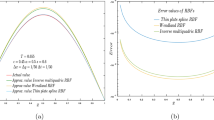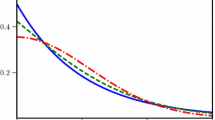Abstract
It is known that at least ten equivalent definitions of the fractional Laplacian exist in an unbounded domain. Here we derive a further equivalent definition that is based on the Mellin transform and it can be used when the fractional Laplacian is applied to radial functions. The main finding is tested in the case of the space-fractional diffusion equation. The one-dimensional case is also considered, such that the Mellin transform of the Riesz (namely the symmetric Riesz–Feller) fractional derivative is established. This one-dimensional result corrects an existing formula in literature. Further results for the Riesz fractional derivative are obtained when it is applied to symmetric functions, in particular its relation with the Caputo and the Riemann–Liouville fractional derivatives.
Similar content being viewed by others
References
Bardaro, C., Butzer, P.L., Mantellini, I.: The foundations of fractional calculus in the Mellin transform setting with applications. J. Fourier Anal. Appl. 21, 961–1017 (2015)
Bayın, S.Ş: Definition of the Riesz derivative and its application to space fractional quantum mechanics. J. Math. Phys. 57, 123501 (2016)
Bochner, S.: Diffusion equation and stochastic processes. Proc. Natl. Acad. Sci. USA 35(7), 368–370 (1949)
Bochner, S., Chadrasekharan, K.: Fourier Transforms, Annals of Mathematics Studies, vol. 19. Princeton University Press, Princeton, N. J. (1949)
Bouchaud, J.P., Georges, A.: Anomalous diffusion in disordered media: Statistical mechanisms, models and physical applications. Phys. Rep. 195, 127–293 (1990)
Bucur, C., Valdinoci, E.: Nonlocal Diffusion and Applications. Lecture Notes of the Unione Matematica Italiana, vol. 20. Springer, Switzerland (2016)
Cai, M., Li, C.P.: On Riesz derivative. Fract. Calc. Appl. Anal. 22(2), 287–301 (2019). https://doi.org/10.1515/fca-2019-0019
Chechkin, A.V., Metzler, R., Klafter, J., Gonchar, V.Y.: Introduction to the theory of Lévy flights. In: Klages, R., Radons, G., Sokolov, I.M. (eds.) Anomalous Transport: Foundations and Applications, chap. 5, pp. 129–162. Wiley–VCH Verlag GmbH & Co. KGaA, Weinheim (2008)
Cusimano, N., Del Teso, F., Gerardo-Giorda, L., Pagnini, G.: Discretizations of the spectral fractional Laplacian on general domains with Dirichlet, Neumann, and Robin boundary conditions. SIAM J. Numer. Anal. 56, 1243–1272 (2018)
Diethelm, K., Garrappa, R., Giusti, A., Stynes, M.: Why fractional derivatives with nonsingular kernels should not be used. Fract. Calc. Appl. Anal. 23(3), 610–634 (2020). https://doi.org/10.1515/fca-2020-0032
Diethelm, K., Kiryakova, V., Luchko, Y., Tenreiro Machado, J.A., Tarasov, V.E.: Trends, directions for further research, and some open problems of fractional calculus. Nonlinear Dyn. 107, 3245–3270 (2022)
Dipierro, S., Savin, O., Valdinoci, E.: All functions are locally \(s\)-harmonic up to a small error. J. Eur. Math. Soc. 19(4), 957–966 (2017)
Dipierro, S., Savin, O., Valdinoci, E.: Local approximation of arbitrary functions by solutions of nonlocal equations. J. Geom. Anal. 29, 1428–1455 (2019)
Duo, S., Wang, H., Zhang, Y.: A comparative study on nonlocal diffusion operators related to the fractional Laplacian. Discrete Contin. Dyn. Syst., Ser. B 24(1), 231–256 (2019)
Dyda, B., Kuznetsov, A., Kwásnicki, M.: Fractional Laplace operator and Meijer G-function. Constr. Approx. 45, 427–448 (2017)
Feller, W.: On a generalization of Marcel Riesz’ potentials and the semi-groups generated by them. In: Meddelanden Lunds Universitets Matematiska Seminarium (Comm. Sém. Mathém. Université de Lund), pp. 73–81. Lund (1952). Tome suppl. dédié à M. Riesz
Gorenflo, R., Iskenderov, A., Luchko, Y.: Mapping between solutions of fractional diffusion-wave equations. Fract. Calc. Appl. Anal. 3(1), 75–86 (2000)
Gorenflo, R., Mainardi, F.: Random walk models for space-fractional diffusion processes. Fract. Calc. Appl. Anal. 1(2), 167–191 (1998)
Hanyga, A.: Multidimensional solutions of space-fractional diffusion equations. Proc. R. Soc. Lond. A 457, 2993–3005 (2001)
Hanyga, A.: A comment on a controversial issue: a generalized fractional derivative cannot have a regular kernel. Fract. Calc. Appl. Anal. 23(1), 211–223 (2020). https://doi.org/10.1515/fca-2020-0008
Hilfer, R.: Experimental implications of Bochner-Lévy-Riesz diffusion. Fract. Calc. Appl. Anal. 18(2), 333–341 (2015). https://doi.org/10.1515/fca-2015-0022
Hilfer, R., Luchko, Y.: Desiderata for fractional derivatives and integrals. Mathematics 7, 149 (2019)
Khan, T.U., Khan, M.A., Chu, Y.: A new generalized Hilfer-type fractional derivative with applications to space-time diffusion equation. Results Phys. 22, 103953 (2021)
Klafter, J., Sokolov, I.M.: First Steps in Random Walks. From Tools to Applications.Oxford University Press, Oxford (2011)
Krylov, N.V.: All functions are locally \(s\)-harmonic up to a small error. J. Funct. Anal. 277, 2728–2733 (2019)
Kwásnicki, M.: Ten equivalent definitions of the fractional Laplace operator. Fract. Calc. Appl. Anal. 20(1), 7–51 (2017). https://doi.org/10.1515/fca-2017-0002
Lischke, A., Pang, G., Gulian, M., Song, F., Glusa, C., Zheng, X., Mao, Z., Cai, W., Meerschaert, M.M., Ainsworth, M., Karniadakis, G.E.: What is the fractional Laplacian? A comparative review with new results. J. Comput. Phys. 404, 109009 (2020)
Luchko, Y.: General fractional integrals and derivatives of arbitrary order. Symmetry 13, 755 (2021)
Luchko, Y.: General fractional integrals and derivatives with the Sonine kernels. Mathematics 9, 594 (2021)
Luchko, Y.: Operational calculus for the general fractional derivative and its applications. Fract. Calc. Appl. Anal. 24(2), 338–375 (2021). https://doi.org/10.1515/fca-2021-0016
Luchko, Y., Kiryakova, V.: The Mellin integral transform in fractional calculus. Fract. Calc. Appl. Anal. 16(2), 405–430 (2013). https://doi.org/10.2478/s13540-013-0025-8
Mainardi, F., Luchko, Y., Pagnini, G.: The fundamental solution of the space-time fractional diffusion equation. Fract. Calc. Appl. Anal. 4(2), 153–192 (2001)
Mainardi, F., Pagnini, G., Gorenflo, R.: Mellin transform and subordination laws in fractional diffusion processes. Fract. Calc. Appl. Anal. 6(4), 441–459 (2003)
Marichev, O.I.: Handbook of Integral Transforms of Higher Trascendental Functions: Theory and Algorithmic Tables. Ellis Horwood, Chichester (1983). [Translation from the Russian edition (1978)]
Meerschaert, M.M., Sikorskii, A.: Stochastic Models for Fractional Calculus. De Gruyter (2012)
Metzler, R., Klafter, J.: The random walk’s guide to anomalous diffusion: a fractional dynamics approach. Phys. Rep. 339(1), 1–77 (2000)
Metzler, R., Klafter, J.: The restaurant at the end of the random walk: recent developments in fractional dynamics descriptions of anomalous dynamical processes. J. Phys. A: Math. Gen. 37(31), R161–R208 (2004)
Ormerod, N.: A theorem on Fourier transforms of radial functions. J. Math. Anal. Appl. 69, 559–562 (1979)
Ortigueira, M.D.: Two-sided and regularised Riesz–Feller derivatives. Math. Meth. Appl. Sci. 44, 8057–8069 (2021)
Ott, A., Bouchaud, J., Langevin, D., Urbach, W.: Anomalous diffusion in “living polymers’’: A genuine Lévy flight? Phys. Rev. Lett. 65, 2201–2204 (1990)
Pagnini, G., Vitali, S.: Should I stay or should I go? Zero-size jumps in random walks for Lévy flights. Fract. Calc. Appl. Anal. 24(1), 137–167 (2021). https://doi.org/10.1515/fca-2021-0007
Paris, R.B., Kaminski, D.: Asymptotics and Mellin–Barnes Integrals. Cambridge University Press (2001)
Podlubny, I.: Fractional Differential Equations. Academic Press, San Diego (1999)
Riesz, M.: L’intégrale de Riemann-Liouville et le problème de Cauchy. Acta Math. 81, 1–222 (1949)
Rubin, B.: Fractional integrals and weakly singular integral equations of the first kind in the \(n\)-dimensional ball. J. Anal. Math. 63, 55–102 (1994)
Rubin, B.: On some inversion formulas for Riesz potentials and \(k\)-plane transforms. Fract. Calc. Appl. Anal. 15(1), 34–43 (2012)
Samko, S.G.: A new approach to the inversion of the Riesz potential operator. Fract. Calc. Appl. Anal. 1(3), 225–245 (1998)
Servadei, R., Valdinoci, E.: On the spectrum of two different fractional operators. Proc. R. Soc. Edinb. A: Math. 144(4), 831–855 (2014)
Shlesinger, M.F., Klafter, J., Wong, Y.M.: Random walks with infinite spatial and temporal moments. J. Stat. Phys. 27, 499–512 (1982)
Stein, E.M., Weiss, G.: Introduction to Fourier Analysis on Euclidean Spaces. Princeton Mathematical Series, vol. 82. Princeton University Press, Princeton (1972)
Stinga, P.R.: User’s guide to the fractional Laplacian and the method of semigroups. In: Kochubei, A., Luchko, Y. (eds.) Handbook of Fractional Calculus with Applications, vol. 2, Fractional Differential Equations, pp. 235–266. De Gruyter, Berlin, Boston (2019)
Südland, N., Baumann, G.: On the Mellin transforms of Dirac’s delta function, the Hausdorff dimension function, and the theorem by Mellin. Fract. Calc. Appl. Anal. 7, 409–420 (2004)
Südland, N., Volkmann, J., Kumar, D.: Applications to give an analytical solution to the Black Scholes equation. Integr. Trans. Spec. Funct. 30(3), 205–230 (2019)
Tarasov, V.E.: General fractional calculus in multi-dimensional space: Riesz form. Mathematics 11, 1651 (2023)
Temme, N.M.: Special Functions: An Introduction to the Classical Functions of Mathematical Physics. Wiley, New York (1996)
Valdinoci, E.: From the long jump random walk to the fractional Laplacian. Bol. Soc. Esp. Mat. Apl. 49, 33–44 (2009)
Valdinoci, E.: All functions are (locally) \(s\)-harmonic (up to a small error) - and applications. In: Farina, A., Valdinoci, E. (eds.) Partial Differential Equations and Geometric Measure Theory, Lecture Notes in Mathematics, vol. 2211, pp. 197–214. Springer, Berlin (2018)
Whittaker, E.T., Watson, G.N.: A Course of Modern Analysis, 4th edn. Cambridge University Press, Cambridge (1952)
Yakubovich, S.B., Luchko, Y.F.: The Hypergeometric Approach to Integral Transforms and Convolutions, Mathematics and Its Applications, vol. 287. Springer, Dordrecht (1994)
Zaburdaev, V., Denisov, S., Klafter, J.: Lévy walks. Rev. Mod. Phys 87, 843–530 (2015)
Acknowledgements
The authors would like to acknowledge Prof. F. Mainardi and Dr. S. Vitali for useful discussions and hints that are hidden in the lines of the present research. Moreover, M. Kwásnicki is acknowledged for pointing out in a private communication some results by B. Rubin who also is acknowledged for availability and providing the related papers, see, [15, 45]. GP is supported by the Basque Government through the BERC 2022–2025 program and by the Ministry of Science and Innovation: BCAM Severo Ochoa accreditation CEX2021-001142-S / MICIN / AEI / 10.13039/501100011033.
Author information
Authors and Affiliations
Corresponding author
Ethics declarations
Conflict of interest
The authors declare that they have no conflict of interest.
Additional information
Publisher's Note
Springer Nature remains neutral with regard to jurisdictional claims in published maps and institutional affiliations.
Appendix: Derivation of the kernel function \(\mathcal {E}(\xi )\) (3.20)
Appendix: Derivation of the kernel function \(\mathcal {E}(\xi )\) (3.20)
By using the rule \(\sin (\theta +\omega )=\sin \theta \cos \omega + \cos \theta \sin \omega \), formula (3.19) can be re-written as
and then we want two functions \(\varphi _1(r)\) and \(\varphi _2(r)\) such that \(\mathcal {M}\varphi _1 = \cot (\pi s/2)\) and \(\mathcal {M}\varphi _2 = 1\).
By noting from [34, formula (2.24)] that
we have, after replacing \(x \rightarrow r^2\), the first pair
Now, let \(\mathcal {M}^{-1}\) be the Mellin inverse transformation then for a given function \(\psi (r)\) it holds \(\psi =\mathcal {M}^{-1}\mathcal {M}\psi \). Therefore, after the exchange of integration order we have
This integral can be understood as a Mellin convolution integral where by definition \(\mathcal {M}^{-1} y^s = q(r/y)\) and, by using the properties of the delta-function, it holds \(q(z)=z \delta (z-1)\) with \(z=r/y\). Function q(r/y) is consistent with \(\mathcal {M}q = y^s\). Thus, by setting \(y=1\), we have also the second pair
Finally it results
from which formula (3.20) follows.
However, also setting \(\mathcal {M}^{-1} y^s = q^*(r/y)= \delta (r/y-1)\) is appropriate for solving the integral through properties of delta-function and it is consistent with the Mellin convolution interpretation and with formula \(\mathcal {M}q^*=y^s\). Thus, in our case, by setting \(y=1\) another suitable choice for function \(\varphi _2(r)\) is \(\varphi _2(r)=\delta (r-1)\). Moreover, by disregarding the Mellin convolution interpretation, also setting \(\mathcal {M}^{-1} y^s = q'(r,y)=y \delta (r-y)\) or \(\mathcal {M}^{-1} y^s = q{''}(r,y)=r \delta (r-y)\) is appropriate and consistent with the formula \(\mathcal {M}q'=\mathcal {M}q{''}=y^s\). Actually, this procedure does not solve the ambiguity emerging from different rearrangements of the delta-function like \(a\delta (r-a)\) and \(r\delta (r-a)\), with \(a>0\), that provide the same Mellin transform. More extensive analysis on the Mellin transform and delta-function are available in literature [52, 53].
About this article
Cite this article
Pagnini, G., Runfola, C. Mellin definition of the fractional Laplacian. Fract Calc Appl Anal 26, 2101–2117 (2023). https://doi.org/10.1007/s13540-023-00190-z
Received:
Revised:
Accepted:
Published:
Issue Date:
DOI: https://doi.org/10.1007/s13540-023-00190-z
Keywords
- Fractional calculus (primary)
- Fractional Laplacian
- Mellin transform
- Radial functions
- Riesz fractional derivative
- Symmetric Riesz–Feller fractional derivative
- Space-fractional diffusion equation
- Lévy stable densities
- Lévy flights
- Anomalous diffusion




